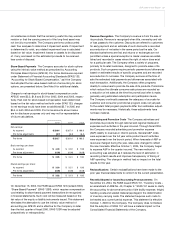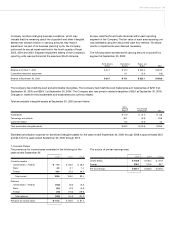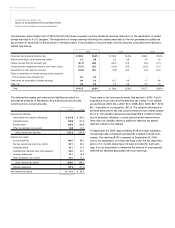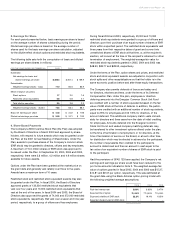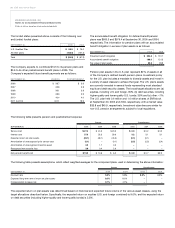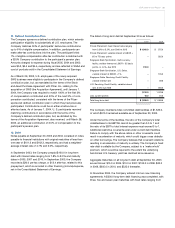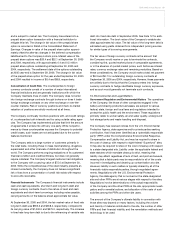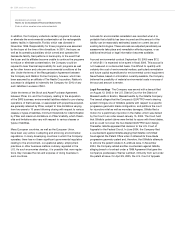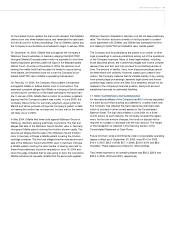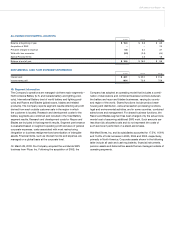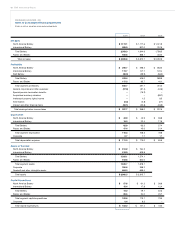Energizer 2005 Annual Report Download - page 39
Download and view the complete annual report
Please find page 39 of the 2005 Energizer annual report below. You can navigate through the pages in the report by either clicking on the pages listed below, or by using the keyword search tool below to find specific information within the annual report.
ENR 2005 Annual Report 37
and is subject to market risk. The Company has entered into a
prepaid share option transaction with a financial institution to
mitigate this risk. The change in fair value of the prepaid share
option is recorded in SG&A in the Consolidated Statement of
Earnings. Changes in value of the prepaid share option approxi-
mately offset the after-tax changes in the deferred compensation
liabilities tied to the Company’s stock price. Market value of the
prepaid share options was $20.4 and $22.1 at September 30, 2005
and 2004, respectively, with approximately 0.4 and 0.5 million
prepaid share options outstanding at September 30, 2005 and
2004, respectively. The settlement date of the options outstanding
at 2005 year-end is September 29, 2006. The change in fair value
of the prepaid share option for the year ended September 30, 2005
and 2004 resulted in income of $5.4 and $8.8, respectively.
Concentration of Credit Risk The counterparties to foreign
currency contracts consist of a number of major international
financial institutions and are generally institutions with which the
Company maintains lines of credit. The Company does not enter
into foreign exchange contracts through brokers nor does it trade
foreign exchange contracts on any other exchange or over-the-
counter markets. Risk of currency positions and mark-to-market
valuation of positions arestrictly monitored at all times.
The Company continually monitors positions with, and credit ratings
of, counterparties both internally and by using outside rating agen-
cies. The Company has implemented policies that limit the amount
of agreements it enters into with any one party. While nonperfor-
mance by these counterparties exposes the Company to potential
credit losses, such losses arenot anticipated due to the control
features mentioned.
The Company sells to a large number of customers primarily in
the retail trade, including those in mass merchandising, drugstore,
supermarket and other channels of distribution throughout the
world. The Company performs ongoing evaluations of its customers’
financial condition and creditworthiness, but does not generally
require collateral. The Company’s largest customer had obligations
to the Company with a carrying value of $75.0 at September 30,
2005. While the competitiveness of the retail industry presents an
inherent uncertainty, the Company does not believe a significant
risk of loss from a concentration of credit risk exists with respect
to accounts receivable.
Financial Instruments The Company’sfinancial instruments include
cash and cash equivalents, short-term and long-term debt and
foreign currency contracts. Due to the nature of cash and cash
equivalents and short-term borrowings, including notes payable,
carrying amounts on the balance sheet approximate fair value.
At September 30, 2005 and 2004, the fair market value of fixed rate
long-term debt was $965.2 and $358.4, respectively, compared to
its carrying value of $1,000.0 and $375.0, respectively. The increase
in fixed rate long-termdebt is due to the refinancing of variable rate
debt into fixed rate debt in September 2005. See Note 12 for addi-
tional information. The book value of the Company’s variable rate
debt approximates fair value. The fair value of the long-term debt is
estimated using yields obtained from independent pricing sources
for similar types of borrowing arrangements.
The fair value of foreign currency contracts is the amount that
the Company would receive or pay to terminate the contracts,
considering first, quoted market prices of comparable agreements,
or in the absence of quoted market prices, such factors as interest
rates, currency exchange rates and remaining maturities. Based on
these considerations, the Company would make a total net payment
of $0.3 and $0.7 for outstanding foreign currency contracts at
September
30, 2005 and 2004, respectively. However, these payments
are unlikely
due to the fact that the Company enters into foreign
currency contracts to hedge identifiable foreign currency exposures,
and as such would generally not terminate such contracts.
16. Environmental and Legal Matters
Government Regulation and Environmental Matters The operations
of the Company, like those of other companies engaged in the
battery and shaving products businesses, are subject to various
federal, state, foreign and local laws and regulations intended to
protect the public health and the environment. These regulations
primarily relate to worker safety,air and water quality, underground
fuel storage tanks and waste handling and disposal.
The Company has received notices from the U.S. Environmental
Protection Agency, state agencies and/or private parties seeking
contribution, that it has been identified as a “potentially responsible
party” (PRP) under the Comprehensive Environmental Response,
Compensation and Liability Act, and may be required to share in
the cost of cleanup with respect to eight federal “Superfund” sites.
It may also be required to share in the cost of cleanup with respect
to a state-designated site. Liability under the applicable federal and
state statutes which mandate cleanup is strict, meaning that
liability may attach regardless of lack of fault, and joint and several,
meaning that a liable party may be responsible for all of the costs
incurred in investigating and cleaning up contamination at a site.
However, liability in such matters is typically shared by all of the
financially viable responsible parties, through negotiated agree-
ments. Negotiations with the U.S. Environmental Protection
Agency,the state agency that is involved on the state-designated
site and other PRPs are at various stages with respect to the sites.
Negotiations involve determinations of the actual responsibility
of the Company and the other PRPs at the site, appropriate investi-
gatory and/or remedial actions, and allocation of the costs of such
activities among the PRPs and other site users.
The amount of the Company’sultimate liability in connection with
those sites may depend on many factors, including the volume
and toxicity of material contributed to the site, the number of other
PRPs and their financial viability, and the remediation methods and
technology to be used.


